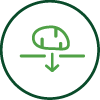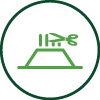Interview: 200th AVR Puma
Description
Agritechnica 2015 featured the new generation of the AVR Puma: the Puma 3. This four-row harvester is the 200th Puma to hit the field. It didn’t start out as the top predator it is today. Over the years, the technology evolved significantly as is usually the case with technology, both on the inside and the outside.
Our colleague Steven Paesschesoone, R&D Manager and concept designer of the Puma series, narrates the history of the Puma.
When did the concept for this four-row self-propelled harvester originate?
The four-row self-propelled harvester dates back to the 1970s. AVR built a potato harvester on a self-propelled Moreau beet harvester with the intention of harvesting both potatoes and beets because the conversion from potatoes to beets was too time-consuming.
As part of our mission statement to help our customers store a higher percentage of sellable crops with less input, we started brainstorming on possible solutions. Before long we came up with the concept of the four-row self-propelled harvester.
Isn’t a four-row harvester more expensive than a two-row?
It is true that the initial investment is somewhat higher but the extra cost is earned back in no time. First of all, the labour cost/ha of the Puma operator is lower with the four-row harvester. In addition, no crops are flattened in the field and the four-row saves time by harvesting everything over a width of 3 metres in a single movement. In turn, this also cuts fuel consumption per hectare. So you’re actually spending fewer resources in return for a bigger yield.
The Puma in its present form wasn’t built overnight. What are its predecessors?
That is true. The Puma 3 is actually our seventh four-row harvester.
At first we teamed up with Moreau, a French company that also manufactured beet harvesters.
In the late eighties, we continued to develop the machine with the Dutch company Riecam. Riecam constructed the engine and the red frame upon which AVR mounted its harvester, recognisable from the green paint.
The next version was the RWD300S, another AVR/Riecam project. Eventually, its successor, the Solanum, was launched around 1997. This was the first series completely designed and developed by AVR.
In 2006, we launched the Puma series. To date, there are three generations: Puma, Puma+ and Puma 3. The major difference between the Puma and the Solanum is the widening of the cleaning channel. The sieving webs now cover the entire width of the rollers instead of just the space in between. This major advantage dramatically increased the cleaning capacity.
With the Puma + we made the switch from a chain drive to a direct drive system for the sieving webs. Also, the rear tyres are now 900 mm wide instead of 710 mm.
As for the Puma 3, we mounted larger front and rear wheels with rear tyres of the ultraflex type. The steering radius was improved both at the front and in the back and we used a new Stage 4 engine by Volvo as well as a new Bosch Rexroth pump set. In order to further increase the cleaning capacity, both the roller table and the pintle belt have been widened. The unique Varioweb module ensures flexible cleaning.
Why would anyone want to work with a Puma 3?
We developed the Puma line to be able to offer our customers a robust, dependable and user-friendly machine. During the harvesting season, the machine needs to stay in operation, period. This is a key criterion in all of our designs. For instance, if one of the sensors fails or in case of a break in the cable, a number of built-in backup systems will keep the machine operational.
The concept was developed based on one central chassis case. The rest of the harvester - the meat and bones as it were – was built on top of it. This simple construction not only makes the machine more robust and more accessible, but also service-friendly.
The steering was also designed to require just a minimum of explanation before putting the machine into operation.
I realise this sounds a bit like a commercial highlighting the advantages of the Puma 3 but this really is some of the feedback we’ve been getting from actual users (laughs) so that’s obviously great to hear.
How many people does it take to develop a Puma?
The Pumas are designed in the R&D department, where I develop the concept together with a number of colleagues. Colleague Joke Cambie and her team develop the pump set with the software and the operating system; other colleagues complete the mechanical design. The process also involves our salespeople who, amongst others, share user experiences. The purchasers order the parts, the production department assembles the machine. Finally, the harvester is tested and certified and then delivered to the customer. In other words, every department is involved.
Are there any fun anecdotes involving the Puma you’d like to share?
There are three, actually:
- I’ve worked for AVR for 25 years and this is the seventh four-row I’ve designed in my career.
- In 2013, we were pleasantly surprised when a Puma featured in the Flemish fiction series ‘Eigen Kweek’. Many of our customers also saw the episode and they shared our pride.
- The fact that the 200th Puma is hitting the field this year is a sign of the confidence the market has in this four-row harvester.
The conclusion is that my colleagues and I will gladly keep developing this machine according to the needs of the market!











